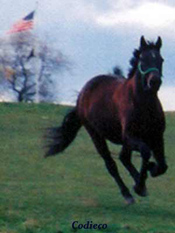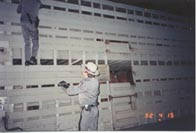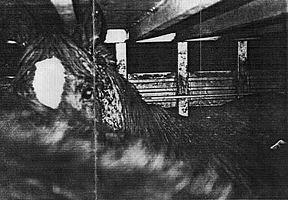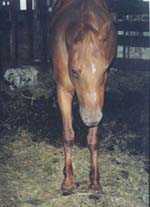
Legislation Information
Pending Legislation
PA's Electronic Bill Room
Type in the word "equine" in the search box to locate bills, (proposed legislation) relating to horses.
Federal Laws
Proposed regs will legalize every inhumane practice identified in the transport of horses to slaughter!

Doubles will be legal for 5 years AFTER the proposed regs go into effect. It has already been 4 1/2 years, that makes for 10 years of the continued use of doubles after this legislation passed..
EPN's Comments
on Proposed Regulations For the 1996 Commercial Transportation of Horses To Slaughter Act
CA Equine Council's
Comments on the Proposed Regulations For the 1996 Commercial Transportation of Horses To Slaughter Act
State Laws
Proposition 6,
The PROHIBITION of Horse Slaughter and Sale of Horsemeat for Human Consumption Act Of 1998, Does Not Violate The Commerce Clause
Horsemeat Laws
1996 Commercial Transportation Of Horses To Slaughter Act
December 7, 2001
Final Rule Commercial Transportation of Horses to Slaughter Act
American Horse Council, American Horse Protection Association, & Humane Society of US
propose to legalize every inhumane practice identified in the transport of horses to slaughter & put the very people identified as the abusers, the "killer buyers" in charge of the horses!
Proposed Regulations For the 1996 Commercial Transportation of Horses To Slaughter Act
USDA Animal & Plant Health Inspection Service, APHIS
Approval of Livestock Facilities;
Interstate Movement of EIA Reactors
USDA Food Safety Inspection Service, FSIS, Regulations
Biological Residues in Horses;
Slaughter of Foaling Mares;
Slaughter of Sick Horses;
USDA APHIS Humane Slaughter Act

AZ Transport Law
CA Transport Law
CT Transport Law
MA Transport Law
MN Transport Law
NY Transport Law
Ag and Markets, Section 359-a

Horses inside double deck cattle trailer stopped by the NYSP. The owner was later convicted & fined $3000.00.
VA Transport Law
Vermont Transport Law
PA Anti Cruelty Law
Title 18, Section 5511
Sign Posted at PA Horse Auctions is NOT the Law!
Sign outside auctions is incorrect!

Sign posted outside 2 PA horse auctions regarding the PA Anti Cruelty Statute is incorrect! " Maybe the posting of this sign has something to do with "the agreement" that the auctions and the PA SPCA have with each other...
U.S. Anti-Cruelty Statutes
PA Domestic Animal Act
Licensing of Dealers & Haulers
EIA Regulations, Coggins Test
PA Dead Animal Act
Requirements for Removal of Dead Animals
PA Animal Markets
General Provisions
Records
Transactions From Trucks
IL Horsemeat Act
Texas Law
Sale of Horsemeat for Human Consumption
Prohibits Sale of Horsemeat For Human Consumption
Texas Attorney General Cornyn States TX Law
Prohibiting Sale of Horsemeat Applies to the 2 Texas Horse Slaughterhouses!
Links
California Voters "Just Say Neigh" to Horse Slaughter!
HoofPAC
Shop online at IGive.com with over 400 great stores you know & love- including Back In the Saddle! Up to 26% of the purchase price is donated to the EPN!
The EPN gets $5 extra the first time you shop!
PayPal accepts credit cards! Please send your tax deductible donation to the:Equine Protection Network, Inc.,
P. O. Box 232, Friedensburg, PA, 17933.
Shop for CD's at CDRush.com & the EPN Benefits!
Put "EPN" in the Coupon Code box when you place your order.
Now you can save money on your favorite music and help the horses at the same time!
HoofPAC is the political action committee that has been formed to end the slaughter of America's horses. Cathleen Doyle, founder of HoofPAC, led the successful Save The Horses campaign in 1998 that made the slaughter of California's horses a felony.

Minnesota Statutes 1996, Table of Chapters
Table of contents for Chapter 346
346.38 Equines.
Subdivision 1. Definition. "Equines" are horses, ponies, mules, and burros.
Subd. 2. Food. Equines must be provided with food of sufficient quantity and quality to allow for normal growth or the maintenance of body weight. Feed standards shall be those recommended by the National Research Council.
Subd. 3. Water. Equines must be provided with clean, potable water in sufficient quantity to satisfy the animal's needs or supplied by free choice. Snow or ice is not an adequate water source.
Subd. 4. Shelter. Equines must be provided a minimum of free choice protection or constructed shelter from direct rays of the sun when temperatures exceed 95 degrees Fahrenheit, from wind, and from freezing precipitation. Natural or constructed shelters must be of sufficient size to provide the necessary protection. Constructed shelters must be structurally sound, free of injurious matter, maintained in good repair, and ventilated.
Subd. 5. Space and cleanliness requirements. Constructed shelters except for tie stalls must provide space for the animal to roll with a minimum danger of being cast. Stalls must be cleaned and kept dry to the extent the animal is not required to lie or stand in fluids. Bedding must be provided in all stalls, kept reasonably clean, and periodically changed. The nature of the bedding must not pose a health hazard to the animal.
Subd. 6. Exercise. Equines must be provided opportunity for periodic exercise, either through free choice or through a forced work program, unless exercise is restricted by a licensed veterinarian.
Subd. 7. Hoof care. All equines must have their hooves properly trimmed periodically to prevent lameness.
Subd. 8. Transportation. A vehicle used to transport an equine must have a floor capable of supporting the animal's weight safely. Floors must be of nonskid construction or of nonskid material sufficient to provide the animal with traction while in transport. A minimum of 12 inches must be allowed between the withers of the largest equine and the structure above the animal while it is in a natural standing position. Sturdy partitions must be provided at a minimum of approximately every ten feet inside the vehicle. Interior compartments of transporting vehicles must be of smooth construction with no protruding or sharp objects and must provide ventilation. Food and water must be provided in sufficient quantities to minimize stress and maintain hydration.
HIST: 1983 c 358 s 4; 1986 c 444
Save America's Horses! |
|||||||||
|
Please send your tax deductible donation to: Equine Protection Network, Inc., P. O. Box 232, Friedensburg, PA, 17933 |
||
|
The official registration and financial information of the Equine Protection Network, Inc., may be obtained from the PA Department of State by calling toll free within PA, 1-800-732-0999. Registration does not imply endorsement. |
||
|
Photos On This Page CANNOT be Used Without Written Permission
|
||


